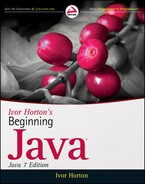Book Description
Ivor Horton's approach is teaching Java is so effective and popular that he is one of the leading authors of introductory programming tutorials, with over 160,000 copies of his Java books sold. In this latest edition, whether you're a beginner or an experienced programmer switching to Java, you'll learn how to build real-world Java applications using Java SE 7. The author thoroughly covers the basics as well as new features such as extensions and classes; extended coverage of the Swing Application Framework; and he does it all in his unique, highly accessible style that beginners love.
Provides a thorough introduction to the latest version of the Java programming language, Java SE 7
Introduces you to a host of new features for both novices and experienced programmers
Covers the basics as well as new language extensions and classes and class methods
Guides you through the Swing Application Framework for creating Swing apps
Uses numerous step-by-step programming examples to guide you through the development process
There's no better way to get thoroughly up to speed on the latest version of Java than with Ivor Horton's latest, comprehensive guide.
Table of Contents
- Cover
- Contents
- Chapter 1: Introducing Java
- Chapter 2: Programs, Data, Variables, and Calculation
- Data and Variables
- Integer Data Types
- Floating-Point Data Types
- Fixing the Value of a Variable
- Arithmetic Calculations
- The op= Operators
- Mathematical Functions and Constants
- Storing Characters
- Bitwise Operations
- Variables with a Fixed Set of Integer Values
- Boolean Variables
- Operator Precedence
- Program Comments
- Summary
- Chapter 3: Loops and Logic
- Chapter 4: Arrays and Strings
- Chapter 5: Defining Classes
- Chapter 6: Extending Classes and Inheritance
- Using Existing Classes
- Class Inheritance
- The @Override Annotation
- Choosing Base Class Access Attributes
- Polymorphism
- Multiple Levels of Inheritance
- Abstract Classes
- The Universal Superclass
- Methods Accepting a Variable Number of Arguments
- Casting Objects
- More on Enumerations
- Designing Classes
- Using the final Modifier
- Interfaces
- Anonymous Classes
- Summary
- Chapter 7: Exceptions
- Chapter 8: Understanding Streams
- Chapter 9: Accessing Files and Directories
- Chapter 10: Writing Files
- Chapter 11: Reading Files
- Chapter 12: Serializing Objects
- Chapter 13: Generic Class Types
- Chapter 14: The Collections Framework
- Chapter 15: A Collection of Useful Classes
- Chapter 16: Threads
- Chapter 17: Creating Windows
- Chapter 18: Handling Events
- Chapter 19: Drawing in a Window
- Chapter 20: Extending the GUI
- Chapter 21: Filing and Printing Documents
- Chapter 22: Java and XML
- Chapter 23: Creating and Modifying XML Documents
- Appendix A: Keywords
- Appendix B: Computer Arithmetic
